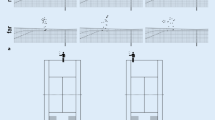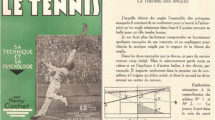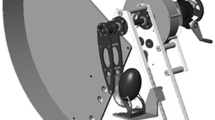Abstract
This study examined whether adding spin to a ball in the free kick situation in football affects a professional footballer’s perception of the ball’s future arrival position. Using a virtual reality set-up, participants observed the flight paths of aerodynamically realistic free kicks with (±600 rpm) and without sidespin. With the viewpoint being fixed in the centre of the goal, participants had to judge whether the ball would have ended up in the goal or not. Results show that trajectories influenced by the Magnus force caused by sidespin gave rise to a significant shift in the percentage of goal responses. The resulting acceleration that causes the ball to continually change its heading direction as the trajectory unfolds does not seem to be taken into account by the participants when making goal judgments. We conclude that the visual system is not attuned to such accelerated motion, which may explain why goalkeepers appear to misjudge the future arrival point of such curved free kicks.



Similar content being viewed by others
References
Abernethy B (1991) Visual search strategies and decision-making in sport. Int J Sport Psychol 22:189–210
Babler TG, Dannemiller JL (1993) Role of image acceleration in judging landing location of free-falling projectiles. J Exp Psychol Hum Percept Perform 19:15–31
Bahill AT, Karnavas WJ (1993) The perceptual illusion of baseball’s rising fastball and breaking curveball. J Exp Psychol Hum Percept Perform 19:3–14
Bootsma RJ, Van Wieringen PCW (1990) Timing an attacking forehand drive in table-tennis. J Exp Psychol Hum Percept Perform 16:21–29
Bray D, Kerwin DG (2003) Modelling the flight of a soccer ball in a direct free kick. J Sport Sci 21:75–85
Brouwer AM, Brenner E, Smeets BJ (2002) Perception of acceleration with short presentation times: can acceleration be used in interception? Percept Psychophys 64:1160–1168
Carré MJ, Asai T, Akatsuka T, Haake SJ (2002) The curve kick of a football II: flight through the air. Sports Eng 4:193–200
de Mestre N (1990) The mathematics of projectiles in sport. Cambridge University Press, Cambridge
Grant AG, Williams AM, Reilly T (1999) Analysis of goals scored in the 1998 World Cup. J Sport Sci 17:826–827
Grealy MA, Craig CM, Bourdin C, Coleman S (2004) Judging time intervals using a model of perceptuo-motor control. J Cogn Neurosci 16:1185–1195
Lee DN, Young DS, Reddish PE, Lough S, Clayton TMH (1983) Visual timing in hitting an accelerating ball. Q J Exp Psychol A 35:333–346
Lee DN, Georgopoulos AP, Clark MJO, Craig CM, Port NL (2001) Guiding contact by coupling the taus of gaps. Exp Brain Res 139:151–159
McBeath MK (1990) The rising fastball—baseball’s impossible pitch. Perception 19:545–552
McIntyre J, Zago M, Berthoz A, Lacquaniti F (2001) Does the brain model Newton’s laws? Nat Neurosci 4:693–694
McLeod P, Dienes Z (1996) Do fielders know where to go to catch the ball or only how to get there? J Exp Psychol Hum Percept Perform 22:531–543
Mehta RD (1985) Aerodynamics of sports balls. Annu Rev Fluid Mech 17:151–189
Montagne G, Laurent M, Durey A, Bootsma RJ (1999) Movement reversals in ball catching. Exp Brain Res 129:87–92
Peper CE, Bootsma RJ, Mestre DR, Bakker FC (1994) Catching balls: how to get the hand to the right place at the right time. J Exp Psychol Hum Percept Perform 20:591–612
Port NL, Lee D, Dassonville P, Georgopoulos AP (1997) Manual interception of moving targets.1. Performance and movement initiation. Exp Brain Res 116:406–420
Regan D (1997) Visual factors in hitting and catching. J Sport Sci 15:533–558
Shanon B (1976) Aristotelianism, Newtonianism and the physics of the layman. Perception 5:241–243
Todd JT (1981) Visual information about moving objects. J Exp Psychol Hum Percept Perform 7:795–810
Werkhoven P, Snippe HP, Toet A (1992) Visual processing of optic acceleration. Vision Res 32:2313–2329
Williams M, Griffiths IW (2002) A kinematic analysis of the prevalence of pre-impact cues in the football penalty kick. J Sport Sci 20:74
Zago M, Lacquaniti F (2005) Cognitive, perceptual and action-oriented representations of falling objects. Neuropsychologia 43:178–188
Acknowledgements
The authors would like to thank the players and coaches from Olympique de Marseille, AC Milan, Schalke 04 and Bayer Leverkusen who participated in this study; Adidas-Salamon Germany who facilitated contact with the clubs, and staff at Milan Lab, Milanello, Italy. The authors also thank Cédric Goulon and Florian Laborde for their assistance in creating the virtual environment.
Author information
Authors and Affiliations
Corresponding author
Electronic supplementary materials
Electronic Supplementary Material accompanies this paper. S1 is a mathematical box describing how the free kick trajectories were calculated. S2, S3 and S4 are movies of the exploration, training and experimentation phases.
S1
(PDF 157 kb)
(MPEG 2,511 kb)
(MPEG 2,353 kb)
(MPEG 1,676 kb)
Rights and permissions
About this article
Cite this article
Craig, C.M., Berton, E., Rao, G. et al. Judging where a ball will go: the case of curved free kicks in football. Naturwissenschaften 93, 97–101 (2006). https://doi.org/10.1007/s00114-005-0071-0
Received:
Accepted:
Published:
Issue Date:
DOI: https://doi.org/10.1007/s00114-005-0071-0




